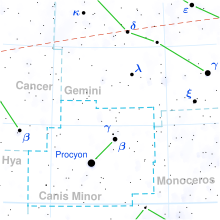Eta Canis Minoris
| Observation data Epoch J2000.0 Equinox J2000.0 (ICRS) | |
|---|---|
| Constellation | Canis Minor |
| Right ascension | 07h 28m 02.075s[1] |
| Declination | +06° 56′ 31.09″[1] |
| Apparent magnitude (V) | 5.25[2] + 11.1[3] |
| Characteristics | |
| Spectral type | F0 III[3] |
| U−B color index | +0.17[2] |
| B−V color index | +0.22[2] |
| Astrometry | |
| Radial velocity (Rv) | +17.2[4] km/s |
| Proper motion (μ) | RA: −3.109 mas/yr[1] Dec.: −43.633 mas/yr[1] |
| Parallax (π) | 10.2172±0.1069 mas[1] |
| Distance | 319 ± 3 ly (98 ± 1 pc) |
| Absolute magnitude (MV) | 0.1[5] |
| Details | |
| η CMi A | |
| Mass | 2.16[4] M☉ |
| Luminosity | 57.5[4] L☉ |
| Surface gravity (log g) | 3.66[6] cgs |
| Temperature | 7,505±66[4] K |
| Rotational velocity (v sin i) | 54[7] km/s |
| Age | 818[6] Myr |
| Other designations | |
| η CMi, 5 CMi, BD+07°1729, GC 9970, HD 58923, HIP 36265, HR 2851, SAO 115477, ADS 6101, CCDM 07280+0657, WDS J07280+0657A[8] | |
| Database references | |
| SIMBAD | data |
Eta Canis Minoris is a binary star[3] system in the equatorial constellation of Canis Minor. Its name is a Bayer designation that is Latinized from η Canis Minoris, and abbreviated Eta CMi or η CMi. The brighter component has an apparent visual magnitude of 5.25,[2] which indicates it is faintly visible to the naked eye. Based on parallax measurements,[1] the distance to this system is approximately 319 light-years (98 pc) from the Sun. It is drifting further away with a line of sight velocity of +17 km/s.[4]
The primary component, η Canis Minoris A, is a yellow-white F-type giant with a stellar classification of F0 III.[3] At the estimated age of 818 million years,[6] it shows a high rate of spin with a projected rotational velocity of 54 km/s.[7] The star has 2.2 times the mass of the Sun mass and is radiating 57.5[4] times the Sun's luminosity from its photosphere at an effective temperature of 7,505 K.[4]
The companion star was first reported by S. W. Burnham in 1872.[9] Designated η Canis Minoris B, it is an eleventh-magnitude star located at an angular separation of 4 arcseconds from the primary. At the distance of this system, this is equivalent to a physical separation of around 440 AU from the main star, taking around 5,000 years to orbit it.[10]
References
[edit]- ^ a b c d e Vallenari, A.; et al. (Gaia collaboration) (2023), "Gaia Data Release 3. Summary of the content and survey properties", Astronomy and Astrophysics, 674: A1, arXiv:2208.00211, Bibcode:2023A&A...674A...1G, doi:10.1051/0004-6361/202243940, S2CID 244398875. Gaia DR3 record for this source at VizieR.
- ^ a b c d Johnson, H. L.; et al. (1966), "UBVRIJKL photometry of the bright stars", Communications of the Lunar and Planetary Laboratory, 4 (99): 99, Bibcode:1966CoLPL...4...99J.
- ^ a b c d Eggleton, P. P.; Tokovinin, A. A. (September 2008), "A catalogue of multiplicity among bright stellar systems", Monthly Notices of the Royal Astronomical Society, 389 (2): 869–879, arXiv:0806.2878, Bibcode:2008MNRAS.389..869E, doi:10.1111/j.1365-2966.2008.13596.x, S2CID 14878976.
- ^ a b c d e f g Luck, R. Earle (September 2015), "Abundances in the Local Region. I. G and K Giants", The Astronomical Journal, 150 (3): 23, arXiv:1507.01466, Bibcode:2015AJ....150...88L, doi:10.1088/0004-6256/150/3/88, S2CID 118505114, 88.
- ^ Jaschek, C.; Gomez, A. E. (1998), "The absolute magnitude of the early type MK standards from HIPPARCOS parallaxes", Astronomy and Astrophysics, 330 (619–625): 619, Bibcode:1998A&A...330..619J.
- ^ a b c David, Trevor J.; Hillenbrand, Lynne A. (2015), "The Ages of Early-Type Stars: Strömgren Photometric Methods Calibrated, Validated, Tested, and Applied to Hosts and Prospective Hosts of Directly Imaged Exoplanets", The Astrophysical Journal, 804 (2): 146, arXiv:1501.03154, Bibcode:2015ApJ...804..146D, doi:10.1088/0004-637X/804/2/146, S2CID 33401607.
- ^ a b Royer, F.; et al. (October 2002), "Rotational velocities of A-type stars in the northern hemisphere. II. Measurement of v sin i", Astronomy and Astrophysics, 393: 897–911, arXiv:astro-ph/0205255, Bibcode:2002A&A...393..897R, doi:10.1051/0004-6361:20020943, S2CID 14070763.
- ^ "eta CMi". SIMBAD. Centre de données astronomiques de Strasbourg. Retrieved 2017-08-31.
{{cite web}}: CS1 maint: postscript (link) - ^ Mason, B. D.; et al. (2014), "The Washington Visual Double Star Catalog", The Astronomical Journal, 122 (6): 3466, Bibcode:2001AJ....122.3466M, doi:10.1086/323920.
- ^ Kaler, Jim, "Eta and Delta-1 CMi", Stars, University of Illinois, retrieved 2017-09-01.

